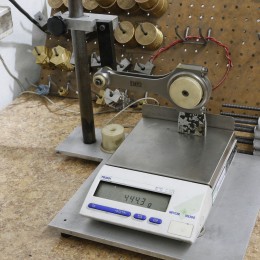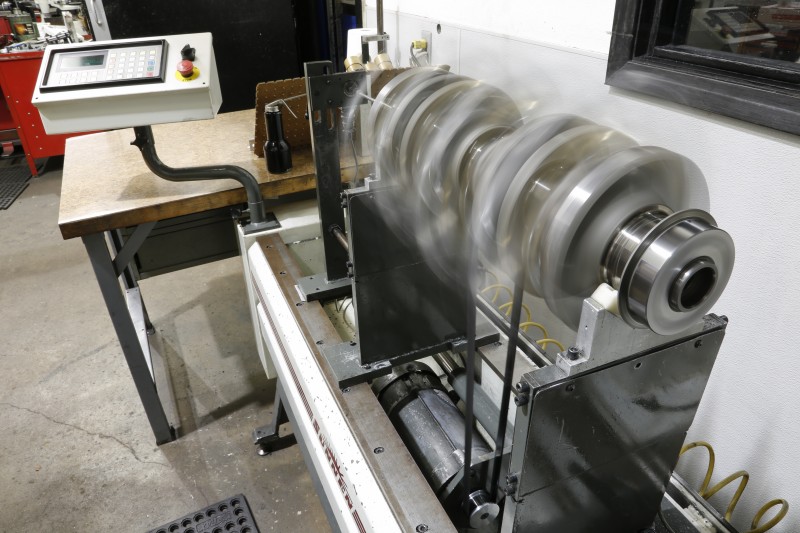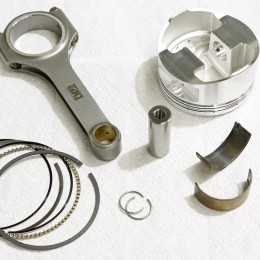Machinists and engine builders have long been taught that, when balancing a crankshaft, its counterweights should equal the weight of the rotating mass, and equal half the weight of the reciprocating mass.
Machinists have used this formula to calculate bobweight for decades.
While this technique works extremely well for most street and race 90-degree V8 engines, the truth is it’s nearly impossible to balance a crankshaft perfectly. That’s because the balancer cannot account for variables like cylinder pressure, ring drag, rod length, counterweight phasing, engine rpm, stroke length, bearing friction, secondary vibrations, rocking couples, and static mass.
All of those factors play a major role in engine balance, yet the traditional mathematical formula used for calculating bobweight completely ignores them. Instead, calculating bobweight is based strictly on measuring rotating weight and reciprocating weight, which is a gross oversimplification of the actual dynamic forces at play inside an engine that affect balancing.
In other words, the traditional method of balancing a crank is, at best, an imperfect science. In fact, it’s not based on any real science or mathematics at all. It’s simply a technique based on trial and error that happens to work well in most 90-degree, cross-plane V8s.
Not surprisingly, as engine rpm and horsepower output increases, the traditional methods used to balance crankshafts become less effective. The big challenge for engine builders is figuring out how to work around these limitations to balance a crankshaft as precisely as possible based on the demands of each particular engine combination. This explains why many engine builders have experimented with techniques such as overbalancing, and why they’re often topics of intense debate.
Crankshaft balancing will always be a compromise, but to get a better handle on how to more effectively balance an engine, we will first outline the basics of the balancing process. In future posts, we will explain the shortcomings of traditional balancing techniques before finally exploring some of the advanced solutions top race teams have experimented with to prolong engine durability in extreme, high-rpm race applications.
 Basics of Balancing
Basics of Balancing
Properly balancing the rotating assembly in any engine build is paramount to maximizing performance and longevity. The typical hot rodder will walk into an engine shop and say they want their rotating assembly balanced to one or two grams. What they think they want you to do is to make sure all the pistons and rods weigh within a couple grams of each other, but most quality aftermarket manufacturers already do that at the factory.
The real goal of balancing a rotating assembly is to make sure that the crankshaft counterweights offset the rotating and reciprocating forces created by pistons and rods.
With today’s lightweight pistons and rods, accomplishing this usually involves removing mass from the crank counterweights. With extremely long-stroke cranks that have shorter counterweights, or rotating assemblies with very heavy pistons and connecting rods, tungsten metal slugs can be pressed into the counterweights to increase mass.
The mass of the crankshaft counterweights should equal 100 percent of the rotating mass and 50 percent of the reciprocating mass. Determining how much mass to add or remove from the crank counterweights requires measuring all of the components in the rotating assembly individually on a high-precision scale. The pistons, rings, wrist pins, pin locks, and the small end of the connecting rods move up and down the bores, and comprise the reciprocating mass of a rotating assembly.

During the balancing process, bobweights are bolted to each rod journal to simulate the mass of a pair of pistons and rods. This is because each rod journal supports two sets of pistons and rods. After bolting the bobweights to the crankshaft, the balancer spins the assembly to roughly 750 rpm. Once the rotating assembly comes to a rest, the LCD display on the balancer indicates the amount and location of weight that needs to be added or removed as the operator slowly rotates the crank by hand.
In Part 2 of this series on engine balancing, we will take a closer look at the shortcomings of traditional balancing techniques.



What would you do with an inline 4 or 6 cylinder engine for balancing?
From what I hear 4 cylinders don’t need Bob weights . They are symmetrical.
[…] part one of Finding Balance, we looked at the basics of engine […]
[…] Read More […]
I’m nearing retirement, i would like to go back to school send me more info. Sincerely tony d.
Should a balancing be done with all the flywheel and pulley on or should it be done as 2 parts( as of to balance the crankshaft 1st before assemble the flywheel and pulley)?
Depends if it a internal or externally balanced engine
I have a question. If you were lightening the rotating assembly for an inline 6 engine would you have to re balance the crankshaft? Given the rods and pistons weights are matched, would you just balance the crank alone without the weights of the rods and pistons? or would you still need to use bob weights when balancing?
I am replacing the crankshaft on my chevy with a new crankshaft, I have a V6 3.1L , so how do I go about the process of replacing the crank shaft. I remove it from the block and then what steps do I need to do to ensure a properly balanced engine.
[…] Finding Balance (Part 1): The Basics of Crankshaft Balancing […]
Need a machine for testing balancing of crankshaft
“In fact, it’s not based on any real science or mathematics at all. It’s simply a technique based on trial and error that happens to work well”
C’mon…if you’re going to write a “tech” article, you should at least get the basics correct.
This is ridiculous.
Hello and thanks for reading. Did you check out the Author’s other two parts of this series? He goes deep into the science behind it, including lab tests and citations from published SAE papers.
Hi if I have my engine rebored then I’m adding extra mass as the piston are heavy than standard at what point do you need to have your crank rebalanced thanks dave